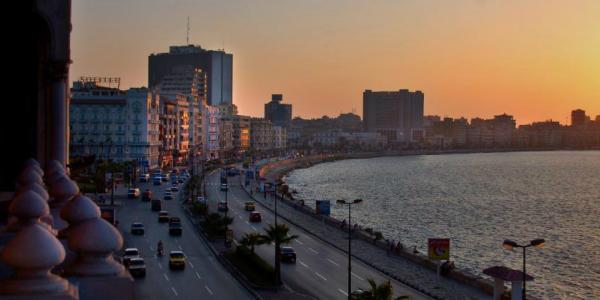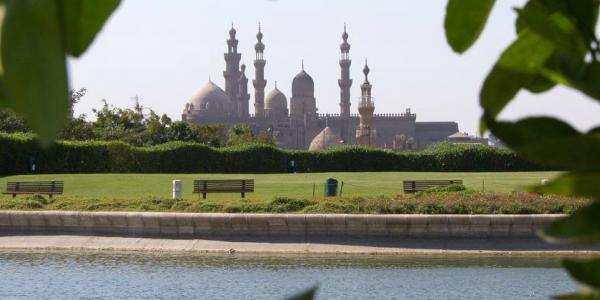Fort Qaitbey/ Citadel of Qaitbey
The Fort was built in the 1480's by Sultan Qaitbey, on the site of Alexandria's famous lighthouse, one of the ancient city’s best-known monuments, and many of the original blocks were used in its construction. The founder of the Citadel was the Mameluke Sultan Qaitbey, who ruled over Egypt and Syria between 1468 and 1496 AD. The Citadel overlooks the Eastern Harbour in the same way as the Ras el-Tin Palace overlooks the Western.
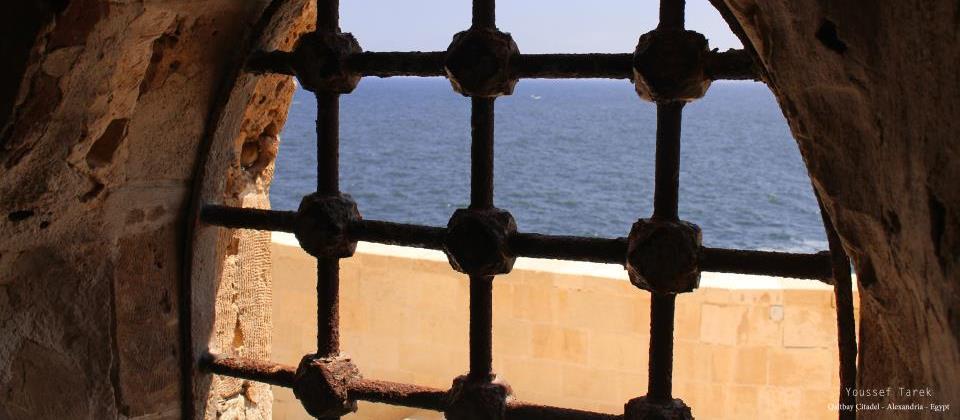
The fort is also the home of the Naval Museum, which houses a collection of interesting artefacts from the wars fought out near the city. You can see relics from Roman sea battles, from the Napoleonic wars when the fort was bombarded, as well as from more recent battles in which it fell to the British. There is also an interesting collection of sea creatures and dioramas.
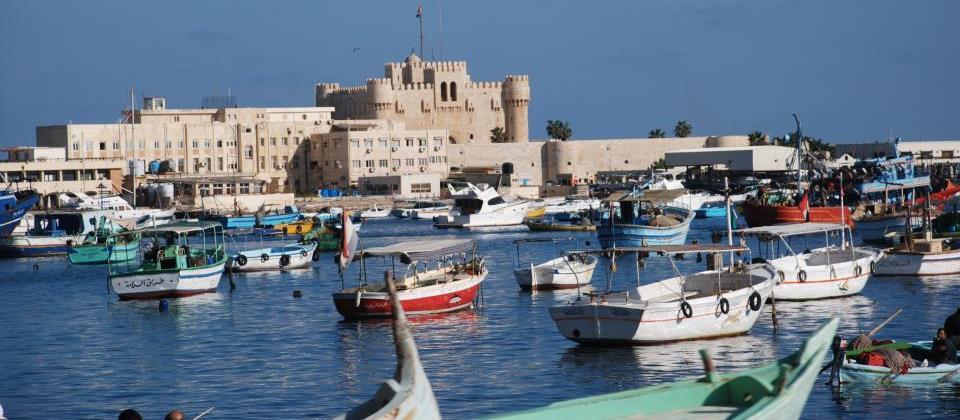
The Serapeum and ‘Pompey’s Pillar’
The ruins of the Serapeum stand on a hill in the south-west of the city, the oldest part of Alexandria and are bordered to the north by a large Muslim cemetery. Little remains today of the site of the cult of the god Serapis, who was created when the cult of Osiris was merged with that of Apis (and several Greek gods) during the reign of Ptolemy I. The King built a small temple to Serapis, which was replaced with a later temple by Ptolemy III and a gold plaque, now in Alexandria’s Greco-Roman Museum, commemorates its foundation in two languages. The temple enclosure was thought to contain the tomb of the sacred Apis Bull and burial vaults for sacred jackals in subterranean galleries. It may also have housed a small library. The temple complex, which was destroyed by Christians in 391 AD, is now an archaeological park with several pharaonic and classical statues and sphinxes found in the area. The most famous monument in the park is the mistakenly named ‘Pompey’s Pillar’, a 30 metre-tall column of red granite, which was erected in 289 AD in honour of the Emperor Diocletian (as described in a Greek inscription on the base). It was named ‘Pompey’s Pillar’ when travellers during the Middle Ages wrongly attributed it to Julius Caesar’s rival Pompey, whom they thought was buried there and it has since become one of Alexandria’s main landmarks.
Kom el-Shukafa catacombs
The famed catacombs of Kom El-Shukafa are five minutes away from Pompey’s Pillar. Initially they were built for a wealthy family who practised a fusion of Ancient Egyptian, Greek and Roman religions; the catacombs of Kom el-Shukafa contained over 300 mummies. Many are decorated with bearded serpents with the crowns of Upper and Lower Egypt, the hovering solar disc above the archway and customary funerary deities together with Greco-Roman motifs. The catacombs are a monumental testament to the enduring myths of Ancient Egypt despite centuries of Greek and Roman rule. Kom el-Shukafa means literally “piles of shreds”.
Mustafa Kamal Necropolis
The Mustafa Kamal Necropolis is located in El-Moaskar El-Romani Street, in the Rushdie District of Alexandria. It has four subterranean tombs that date back to the 3rd and 2nd centuries BC.
The first and most impressive tomb comprises several chambers that are accessed by a stairway that leads to loculi arranged around a central open courtyard. In the middle of this courtyard there is an altar with three doorways behind it that lead to a large corridor. This courtyard is famous for its Doric columns with clearly visible decorations, including a small sphinx on a plinth and a painted frieze depicting ladies and horsemen in a libation scene. Passing the courtyard, there is a doorway to the western room, which has a list of names on the walls in Greek. It is thought that these are the names of visitors or of people buried inside this room. There is a painting on the wall of a wheel with an elaborate system for drawing water up into a basin, where it then runs through a ceramic pipe into two small tanks, and then into a larger one.
The second tomb is accessed via stairs that lead to the central courtyard and to a number of other rooms. These rooms also have some fascinating pieces, including a pair of benches that were used for prayers, an offering table made out of limestone, and a sarcophagus with pictures of dancers, flowers and chariots in lovely colours. Another room was used as an annex where funeral banquets were prepared.
The bright colours and the relief inscriptions in the Mustafa Kamal Necropolis illustrate the daily lives of the dead.
Necropolis of Anfushi
During the Ptolemaic period (4th-1st century BC), the Greeks preferred to be cremated after death, but later on, they gave up the practice of cremation and started to embalm bodies, as the Egyptians once had done.
In Alexandria there were two large burial grounds located to the east and the west of the city; the necropolis of Anfushi was in the western one (near the site of the Ras el-Tin Palace today) and dates back to the 2nd and 1st centuries BC. The necropolis was discovered between 1901 and 1921.
The Anfushi tombs are decorated in a blend of Pharaonic and Ptolemaic styles. There are five tombs in this area, two of which attract most attention due to their spectacular decoration.
The tombs consist of a series of corridors and rooms with niches carved out of the rock. The layout is quite complicated, especially because they were not made for a single person or even a family, but for a whole corporation.
Tomb 1 has a staircase cut into the rock that leads to an open courtyard. The wall around the entrance is covered with a thin layer of plaster. On the east side of the courtyard we can see two rooms with an Egyptian-style cornice above the entrance. The burial chamber is small and low, with a granite sarcophagus at the far end. The wall of the northern part is decorated in “inlaid style”, (imitation of alabaster slabs and rectangular blocks in equal layers).
Tomb 2 is similar to Tomb 1 and is also decorated in the Egyptian style. It consists of a staircase that leads to an open courtyard with burial chambers on its sides. On the wall facing the entrance there is a typical Egyptian scene of purification of the dead showing the deceased person with Osiris, Horus and Isis. Another scene on the right shows the deceased person and Horus standing in front of Osiris, who is sitting on his throne while a jackal stands at his feet.
In the third tomb, the left-hand burial chamber contains a large sarcophagus of pink Aswan granite.
The remains of the fourth tomb have a different design from the others, with a ramp leading to an open courtyard with two doors. The first door leads to a room that was used for funeral banquets (triclinium) and has three loculi (burial openings). The second door leads to two rooms carved into the rock that were also used for funeral banquets. They also have various loculi.
The Anfushi tombs have a characteristic decoration of geometric motifs in black, white, blue and red squares, lozenges and octagons.
Al-Shatby Necropolis
The Al-Shatby Necropolis is situated in the Al Shatby area of Alexandria, directly opposite the Collège Saint Marc. The Shatby tombs date back to the fourth century BC (360 BC) and were discovered accidentally in 1904. They are considered to be the oldest tombs in Alexandria and look like an old Greek house, with a doorway that opens into a corridor and two chambers. Two burial methods were used in these tombs: the first was to lay out the body on a funerary bed (as in the main tomb), and the second consisted of loculi cut into the walls as burial niches and closed off with slabs.
Vessels and jars containing human ashes were found in one of the excavated tombs. The façade of the tomb consists of a number of short columns that are connected with screen walls. These are decorated with false doors that symbolized the threshold between the worlds of the living and the dead through which the spirit of the deceased could come and go.
The complex is surrounded by a pathway of flowers, shrubbery and remnants of Greco-Roman funerary monuments, giving the tombs a marvellous setting.
Roman Amphitheatre
The Roman Amphitheatre in Alexandria was probably built in the fourth century AD. It is located in the heart of the city in what is now Kom El-Dikaa and has a diameter of about 33 metres. Although it was partially destroyed during the earthquake that hit Alexandria in the 6th century AD, it still has a clearly defined shape that testifies to its original splendour. The amphitheatre was discovered by chance in 1960 during the excavations in search of the tomb of Alexander the Great. Evidence and traces of engravings show that it was used in three eras (Roman, Byzantium and early Islamic). For example, the Byzantine Celtic cross inside a circle found in one of the holes at the entrance symbolizes Christianity and Christ.
The architectural design of this amphitheatre is unique, in that it has an open-air site with raised seating, in a U-shape with thirteen rows of marble seats. The seats are numbered in Roman numbers and letters from the bottom up to facilitate the seating plan in a theatre that had a capacity of 600 spectators. The steps and the rows of the amphitheatre are built on top of a thick white limestone wall and are surrounded by another wall. There were five boxes for local VIPs, only two of which survive in good condition. These boxes are covered with domes supported by various pillars to protect the spectators from the changing weather and to amplify the sound in the theatre.
There is an orchestra pit in the centre, and at the western entrance there are two halls adorned with mosaics with geometrical designs. During the Roman Empire, the theatre had two adjoining rooms at the north and south ends where the spectators would wait before coming in. The theatre was used for a variety of purposes including celebrations, poetry competitions, and gladiator combats. It was also a venue for lectures and conferences. Its unique design with the domes and the orchestra pit meant that it was also an excellent musical auditorium. Today it is considered one of the important tourist attractions in Alexandria and is used for holding national and international cultural and musical events.
The only surviving royal tomb In Alexandria is the Alabaster Tomb, which was uncovered in 1907. It has all the attributes of a royal tomb, to the point that it has even been argued that it may be the burial place of Alexander the Great. Unlike other tombs found in Alexandria, it seems to follow a Macedonian architectural model and is constructed with monolithic alabaster slabs.
The tomb is the only one in Alexandria built by an ordinary man (not a king or prince). He was a knight called Isadoros (meaning “ISIS’ gift”), whose foot was broken in an accident with his war chariot. He appealed to the gods to heal his foot, vowing to Isis that he would make the booted white marble foot that was sculpted on the square marble column with an inscription in Greek.
The Goddess Isis appeared in a statue wearing the Greek tunic knotted at the chest. It is now on display in the Greco-Roman Museum in Alexandria.
The temple has two floors. The lower floor was intended for prayer and worship, while the upper was the priests’ house.
The stairs leading to the lobby were crowned by four columns made of Ionic marble. In the centre of the columns there is a small pillar topped with two votive feet, in reference to the story of the construction of the temple. Behind the columns we come to the main chamber of the temple, a square room, and a stone plinth topped with five white marble statues representing the gods of the temple: Isis, Harpocrates, Hermanubis and canopic statues of Osiris.
A narrow staircase located in the eastern wall of the Temple led to two rooms where the priests lived.
There are no inscriptions on the interior and exterior walls of the temple.
Caesareum Temple
This temple was located in what is today Saad Zaghloul Square, one of the busiest squares in Alexandria. It was constructed during the reign of Queen Cleopatra VII (1st century BC) in honour of Julius Caesar, but she died before it was finished. Augustus or, as he later became known Emperor Octavian, continued the construction after her death. Once finished, Octavian dedicated the temple to himself, establishing a cult for his worship there.
Unfortunately the building is in ruins and nothing remains of the original construction. The temple once had two red granite obelisks adorning the main entrance and façade, called Cleopatra’s needles. The first of these two obelisks was relocated to London in 1877, where it was placed on the banks of the River Thames. The second was shipped to New York and now stands in Central Park.
The first obelisk bears the name of Emperor Octavian III while the second has the names of Set I and Ramses XI inscribed on its sides. It seems that this obelisk was brought from Al Matareya to decorate the temple façade twenty years after Cleopatra’s death. The philosopher Hypatia was murdered on the steps of this temple in March 415 AD.
Today a statue of the great Egyptian politician Saad Zaghloul stands on the site of what was once the Caesareum Temple.
The Cisterns of Alexandria
In 331 BC Alexander the Great conquered Egypt and established a new capital city: Alexandria. The supply of fresh water had always been a problem in the region, but Alexander the Great wanted to build his new city there between a brackish lake and the salty sea.
The cisterns are tanks for collecting water. They were usually built underground out of firebricks and stone to withstand decay from moisture. Construction materials were frequently coated with lime and red-brick dust to prevent water leakage.
Ptolemy ordered a canal to be dug from the Canopic branch (Mahmoudieh Canal) of the River Nile to the gates of the new city, from where the water was brought via a network of channels into underground vaults for storage. This ancient cistern, enlarged during the late Roman and Byzantine periods, is three floors deep and so elaborately constructed that it looks more like a cathedral than a water supply complex.
The maintenance of these cisterns was a perpetual concern, not only during Egypt’s Greco-Roman period, but also for the Muslim dynasties. A large number of inscriptions and literary texts refer to the cleaning, widening and repair of these cisterns. In Description de l'Egypte the engineers that took part in Bonaparte’s expedition to Egypt mention five underground aqueducts and more than 400 cisterns.
In 1869, the astronomer Mahmoud el Falaki was commissioned by Khedive Ismail to draw up a map of the ancient city. He counted up to 700 cisterns located under the streets of Alexandria without indicating whether they were all still in use.
In 1990 only one sole cistern was open to the public: el-Sahrig el-Nabih (named after the Mameluke Supreme Judge Mohamed ben el-Nabih), situated beneath the Shallalat Gardens, next to the al-Salama hospital. It has three square floors (11.75 x 11.75 m).
Bibliotheca Alexandrina
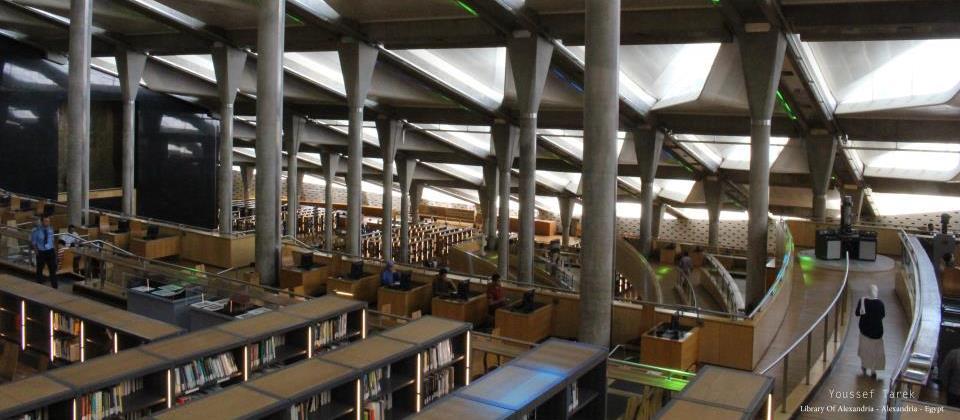
This is the largest reading space in the world with over 2,000 chairs for potential readers. The new library symbolizes the renaissance of Alexandria as a Mediterranean megalopolis. The futuristic disc-like structure was opened in 2002 and aims to become a great cultural centre, going some way to replace the ancient Alexandrian library that was tragically destroyed some 2000 years ago. International aid has been injected into the project, a huge ultra-modern 11-storey structure with a roof made of glass and steel panels, which took ten years to complete. The whole building is covered in scripts and letters in almost all the world’s languages to reflect the multi-cultural heritage and spirit of the library. By the time its collection is complete it will house more than 8 million books. A traditional visit to the Library starts in the main hall where visitors are offered the assistance of multi-lingual guides (Arabic, English, French, Italian and Spanish). The library houses four permanent museums dedicated to Antiquities, Manuscripts, the former Egyptian President Sadat, and the History of Science. A remarkable feature of the library is CULTURAMA, an interactive display of Egypt’s cultural heritage: 9 huge computer screens are arranged in a semi-circle to create a display resembling traditional war or history panoramas.
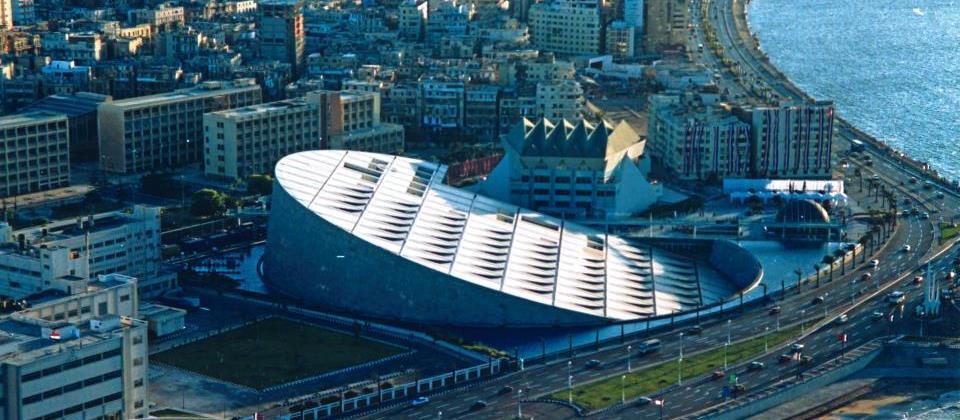
Mosque of Abu al-Abbas al-Mursi
This beautiful mosque is Alexandria's largest and one of the most important Islamic monuments in the world. It has a cream-coloured façade, four great domes, arabesque designs and a 73-metre high minaret that was rebuilt in 1943.
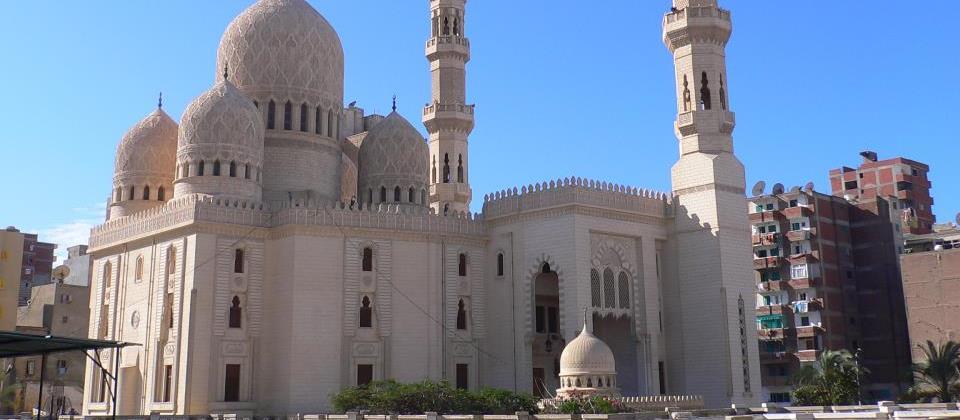
Built in 1775 to commemorate the life of an Andalusian Sheikh, Ahmed Abu al-Abbas al-Mursi, who was buried on the site, it is one of the most visited mosques on the White Med coast.
The colonnade of elongated arches, the eight monolithic granite columns and the beautiful marble floor are all worthy of mention.
Attarine Mosque
The Attarine Mosque is in the centre of the Attarine district, one of the most interesting neighbourhoods in Alexandria. This mosque was originally built on the site of a fourth century church dedicated to Saint Athanasius. With the arrival of Islam, the church was transformed into a mosque that has undergone many further changes over the centuries. Its current good condition is thanks to the Governor of Egypt Abbas II, who ordered its restoration at the beginning of the 20th century.
This district is well known for its famous marketplace, the Al-Attarine souk. This traditional souk is a maze of narrow alleys and pedestrian streets, bursting with all types of shops on both sides of the streets, with shopkeepers selling all kinds of souvenirs and traditional Egyptian artefacts, such as sheesha pipes, colourful blown glass products, gallabiya tunics, belly-dancing costumes, spices and antiques. The Al-Attarine Souk specializes in antiques.
The Mosque of Imam Busiri (Bosseri)
"For verily a lover is deaf to those who advise him", so goes one of the early lines of Qasidat al-Burda (the Poem of the Cloak) written by the poet Imam Busiri, who died in 1296 AD. The poem became so famous that it is still recited today by believers from Yemen to Morocco. His tomb and mosque in the Anfushi district of Alexandria have recently been restored and play an important role in the life of the city, attracting visitors from all over the world. The mosque features beautiful mural calligraphy, including 94 verses of Qasidat al-Burda inscribed in Ta'liq script, as well as verses from the Quran.
Nabi Daniel Mosque
There are two different accounts as to who the Mosque is named after. In the first, the mosque is named after the Biblical prophet Daniel whose life story is largely based on the Old Testament but also incorporates many aspects of that of Alexander the Great. The Macedonian king founded the city of Alexandria and was buried in a golden sarcophagus on the site of the mosque. Alternatively, the mosque may have been named after Sheikh Mohammed Daniel, a Kurd who came to Alexandria from Mosul in the 15th century. The present Mosque of Nabi Daniel was built at the end of the 18th century on the site of a 4th century Roman temple and restored in 1823 by Mohamed Ali.
Al-Shurbagy Mosque
The Shurbagy mosque was built in 1758 in the Turkish district of Alexandria, which was first inhabited after the Ottoman conquest of Egypt. Its founder was al-Haj Abd al-Bakki el-Shurbagy, who died in 1763.
There is a marble plaque above the entrance to the prayer hall with a commemorative poem describing the mosque in detail. When it was analysed, some missing original parts were uncovered after newer decorations had been removed. The original minaret was destroyed when the British Mediterranean Fleet bombarded Alexandria on July 1882. The Mihrab is still decorated with the original Kufic inscriptions.
Just like the Terbana mosque, the al-Shurbagy mosque is built above street level and consists of two floors that are rectangular in shape. The ground floor includes a group of stores, ablution basins and coffee shops. The mosque is located on the first floor and has a decorated wooden ceiling.
Terbana Mosque
The Terbana mosque was built in what is now Faransa Street in the Turkish district in 1684 by Haj Ibrahim Terbana, a Moroccan merchant who spent his life in Alexandria.
This mosque was built above street level and has two floors. The entrance gate is built of two-tone bricks. The ground floor is occupied by shops, and the rectangular prayer hall is on the first floor. It covers an area of 350 square meters and has a richly decorated wooden ceiling with colourful reliefs. The ceiling is supported by four rows of arches that rest on eight columns. There is an internal terrace for women’s prayers which can be accessed directly from the outside via a staircase.
The Terbana Mosque has two enormous granite columns topped with Corinthian capitals, and other columns that date back to the Greco-Roman period and once belonged to old demolished buildings or stood in public squares.
The “Mihrab”, which indicates the direction for praying towards Mecca, is in a corner of the Mosque and is covered with North African style ceramics.
The Minarets have three sections. The first is octagonal and has a circular wooden staircase. The second section has a terrace from which the “Muezzin” calls the faithful to prayer, while the third section has a base called a kursy, a cylinder column called a badan and a dome or khoza.
Church of the Sacred Heart
Built in 1924, the Church of the Sacred Heart is a Catholic church, primarily attended by Alexandria’s Roman Catholic community. The patron saint is St. Francis, an Italian monk born in 1181 who also founded the Franciscan religious orders. The church is worth visiting for its breathtaking religious art, with icons, murals, figurines and most of all, exquisite stained glass pieces.
One of the interior walls is decorated with images from the life of Christ while the opposite wall recounts episodes in the life of St. Francis. St. Clare, who founded the Franciscan Order for Girls, also features prominently in the stained glass windows. There are several altars and a beautiful pulpit engraved with events from the life of St. Francis. Swimming angels and a stunning painting of Jesus Christ connect the walls to the beautiful ceiling, which has even more artistic delights.
Coptic Cathedral
Although the Coptic Cathedral looks Byzantine, it was built in the 20th century on site of a 4th century church. It has beautiful icons and mosaics that fill the silence of the cathedral with a surreal beauty.
The Greco-Roman Museum
With a great collection of art and artefacts that date back to the origins of ancient Alexandria, the Greco-Roman Museum has a neoclassical façade with the name MOYXEION (museum in Greek). With 27 exhibits that showcase Hellenic statues, busts of Roman emperors, sarcophagi, mummies, Tangara figurines and early Christian artefacts, the museum captures over 2,000 years of Greco-Roman history in Egypt.
The Museum of Fine Arts
The permanent collection includes sculpture, architecture and photography by contemporary Egyptian and foreign artists. The museum, which houses approximately 1,500 pieces, is full of drawings of rural life and surrealist paintings. It was once known as the Hussein Sobhy Museum, after a governor of the city that played an important role in Alexandria’s art movement. The building itself dates back to 1954. Every two years it organizes a biennial with art from around the Mediterranean.
Cavafy's Museum
The museum is located on the 2nd floor of an old building, once owned by the Alexandria-raised Greek poet Konstantin Cavafy, who lived there for 25 years before his death in 1933. Since 1992, the poet’s apartment has been turned into a museum, housing some of his personal effects, including his old brass bed, some icons on the walls, and the modest table he used as a desk. The most interesting part of the museum is the “bindery”, a small room where the poet made his own poetry pamphlets. Many of his books, manuscripts and letters are also on display on tables in the different rooms of the house.
The Royal Jewellery Museum
Housed in an exquisitely decorated villa that once belonged to King Farouk’s first wife, the Royal Jewellery Museum is a true gem, with a great collection of glitzy artefacts that belonged to the excessive and extravagant Egyptian monarch and his family.
Mahmoud Said Museum
This museum takes you back in time to the 40’s and 50’s, the golden days of 20th Century Egypt and a time when, after retiring from his duties as a judge, Mahmud Said (1897-1964) started to paint Egypt as he saw it, mixing echoes from the past with modern techniques such as cubism and social realism. Housed in the artist’s beautiful Italian-style villa, the museum has about 40 of Said’s paintings on display.
Alexandria National Museum
Located close to the city centre, the Alexandria National Museum nicely sums up the history of Alexandria on the three floors of the now renovated Italianate style al-Saad Bassili Pasha Palace. The Museum has over 1,800 artefacts from the four main ages of Egypt: Ancient, Greco-Roman, Coptic and Islamic. There is also an array of more modern items such as royal jewels and an interesting collection of antique coins.
Alexandria Opera House
The “Sayed Darwish Theatre” was opened in 1921 during the reign of Sultan Fuad I and was designed by the French architect George Baroque, who was inspired by the Vienna State Opera and the Odeon Theatre in Paris. It was originally called the “Muhammad Ali Theater”, but was later renamed in honour of Sayed Darwish due to his pioneering role in Arab music.
The Theatre was refurbished in 2004 and today features performances by the orchestras, opera and ballet companies from the Cairo Opera House, together with the different Arabic music ensembles and the modern dance group. There are also visiting companies and recitals by local and foreign performers, Cultural Weeks, and Arab and international festivals.



